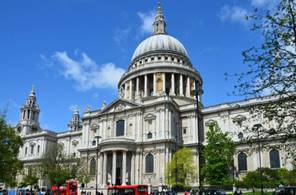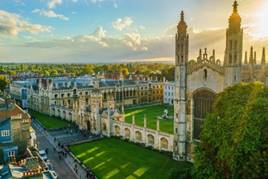
1. St. Paul’s Cathedral is situated in the City of London. It was designed by Sir Christopher Wren (1632s 1723) who was not only an architect but also one of the best geometers of his day, a mathematician and astronomer.
It took Wren 35 years to build the Cathedral which is the greatest of English Churches. It is considered to be a fine specimen of Renaissance architecture.
The Cathedral is 515 ft long and 180 ft wide. Its famous dome is the largest church dome in the world after St. Peter’s in Rome.
2. The City occupies a site which was Norman London. It is a very small part of London (only one square mile). About ten thousand people live in the City but about 500,000 of them work there.
The City can still show the remains of its defensive wall and some other signs of the Roman time. In other parts of the City almost every stone, every wall, every house is Saxon or Norman or connected with some famous man, book or historical event.
The City of London was described by a Roman historian as a “busy emporium for trade and traders” and this description could have been applied to it at any time since then. The City still remains one of the most important commercial centres in the world.
3. William Shakespeare, the greatest English writer of drama, was born in 1564 in Stratford-on-Avon. We do not know everything about Shakespeare’s early life. But we know that he studied at the Grammar School in Stratford, and that lie became interested in the theatre when lie was still a boy.
In 1586 Shakespeare went to London, where he worked in the theatre for some years before he began to write his own plays.
Shakespeare soon became well-known in London literary circles. Every play that he wrote was good news to the people of the capital. Queen Elizabeth liked Shakespeare's plays, and the actors were often invited to play before the Queen and later before King James - a great honour in those days. By the end of the 16th century, Shakespeare and his friends had enough money to build their own theatre - the famous Globe Theatre.
4. The University of Cambridge was founded in the twelfth century. It was formed on the model of European continental universities, in particular that of Paris. Until the fifteenth century the history of Cambridge was not as significant as that of Oxford. But by the end of the seventeenth century the University was the home of Isaac Newton - professor of mathematics from 1669 till 1702 whose influence was deep and permanent. At that time serious tests were offered to the candidates for degrees. During the early part of the nineteenth century examinations were greatly improved and written examinations were more often used than oral ones.
5. Conan Doyle started the fashion of tile detective story. Today the fashion goes on.
And what sort of man is Sherlock Holmes? We learn a lot about him from the stories in which he appears. He is a quiet man, who only speaks when he has something to say. He smokes a pipe (he has a collection of them). He plays the violin. He carries a large magnifying glass. He lives at 221B Baker Street in London.
If you go to London, you will not be able to find 221 B Baker Street. But instead, you can go to a pub called the “Sherlock Holmes”. In that pub there is a room exactly like Sherlock Holmes's room at 221B Baker Street as described in Conan Doyle’s stories. On the walls there are drawings from the original editions about Sherlock Holmes.


1. _________________________ 2. ____________________________


3._____________________________ 4. _________________________
5. _____________________________

Материалы на данной страницы взяты из открытых источников либо размещены пользователем в соответствии с договором-офертой сайта. Вы можете сообщить о нарушении.